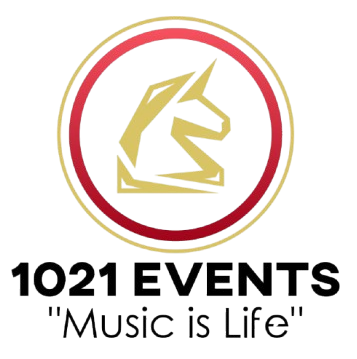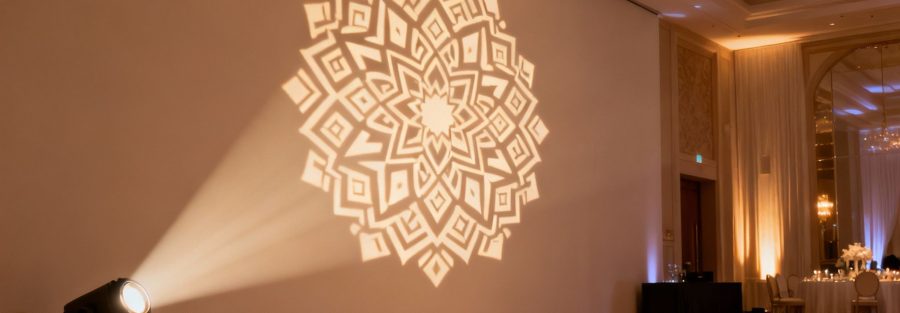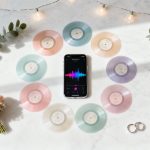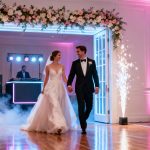You’ve probably seen it before—a stunning monogram splashed across a wedding dance floor or a company logo projected crisply onto a wall at a corporate event. Ever wondered, "How did they do that?" The answer is gobo lighting, and it’s one of the coolest and most effective tricks in the event design playbook.
It’s a deceptively simple technique that lets us project just about any design you can dream up onto a surface, turning a blank wall into a breathtaking focal point.
The Secret Behind Projected Images
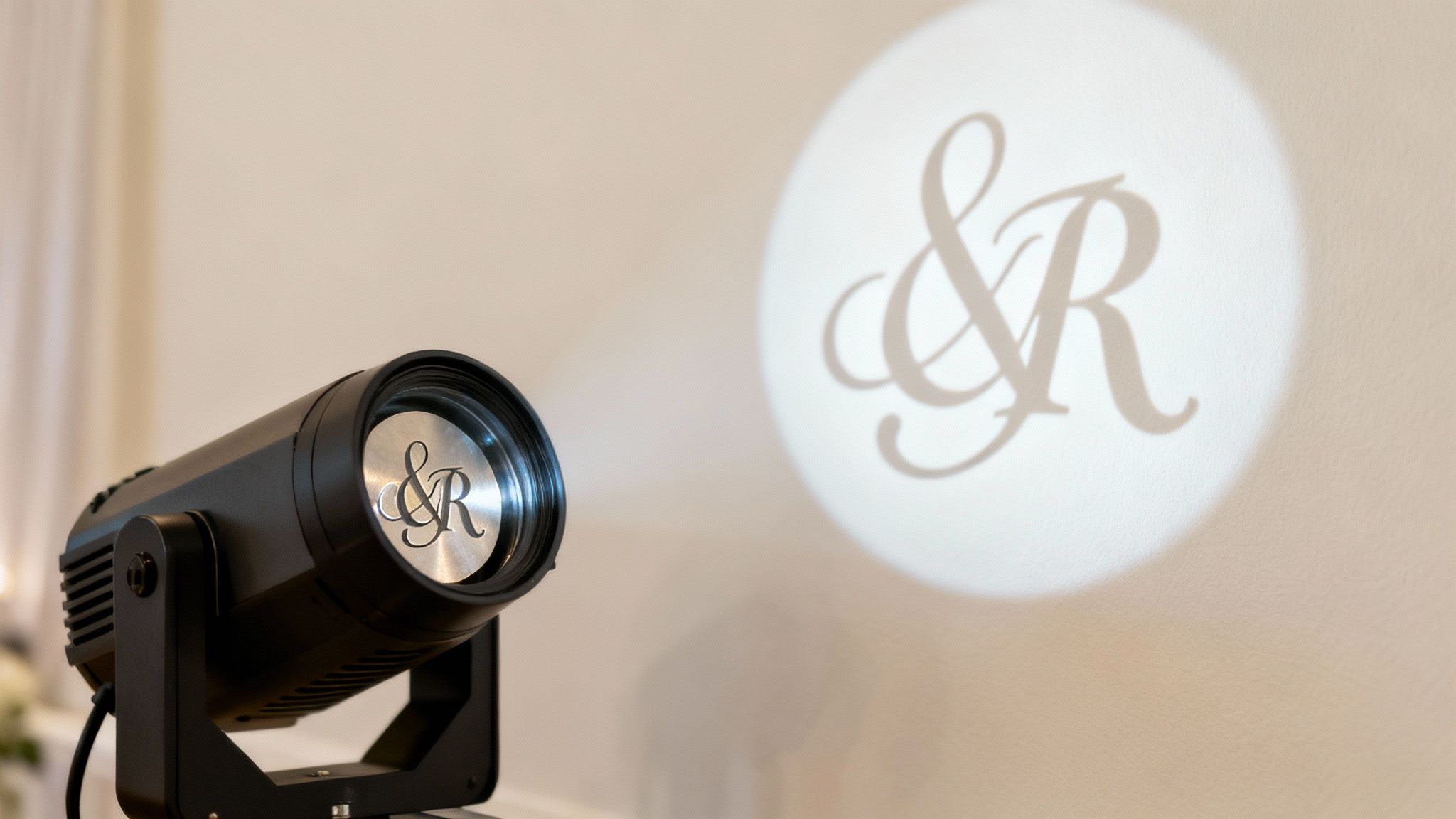
So, how does gobo lighting actually work? The easiest way to wrap your head around it is to think back to making shadow puppets. You have a light source (a flashlight), your hands (the stencil), and a wall (the surface). By shaping your hands, you block the light to create an image.
Gobo lighting operates on that exact same principle, just with a lot more precision and professional gear.
The name 'gobo' itself has a pretty cool backstory, reportedly popping up in old-school cinema studios around 1933. The common theory is that it's short for 'go-between' or 'go-before optics,' since the disc literally goes between the light and the lens.
At its core, a gobo is just a small disc, usually made of metal or glass, with a pattern cut or etched into it. We slide this disc into a special light fixture—a gobo projector. When we fire up the light, it shines through the pattern and projects that image perfectly onto a dance floor, a wall, or even the side of a building.
The Three Core Parts of Gobo Lighting
The whole effect really just comes down to three key pieces working in harmony. Once you see how they fit together, the "magic" becomes surprisingly simple. If you're curious about all the different fixtures we use, you can find more details in our complete guide to event lighting rentals.
To make it even clearer, here’s a quick breakdown of what makes it all happen.
The Three Core Parts of Gobo Lighting
A quick summary of the essential components that make gobo lighting possible.
| Component | Analogy | Its Role in the Process |
|---|---|---|
| The Gobo | The Stencil | This is the small physical disc where your custom design, like a monogram or logo, is etched. |
| The Gobo Projector | The Flashlight | A powerful, specialized lighting fixture that holds the gobo and provides the bright light source. |
| The Surface | The Canvas | This is simply where your image will be projected—a wall, floor, ceiling, or even a tent. |
And that’s really all there is to it! By combining these three elements, we can create custom visuals that completely transform a space.
Choosing the Right Gobo for Your Vision
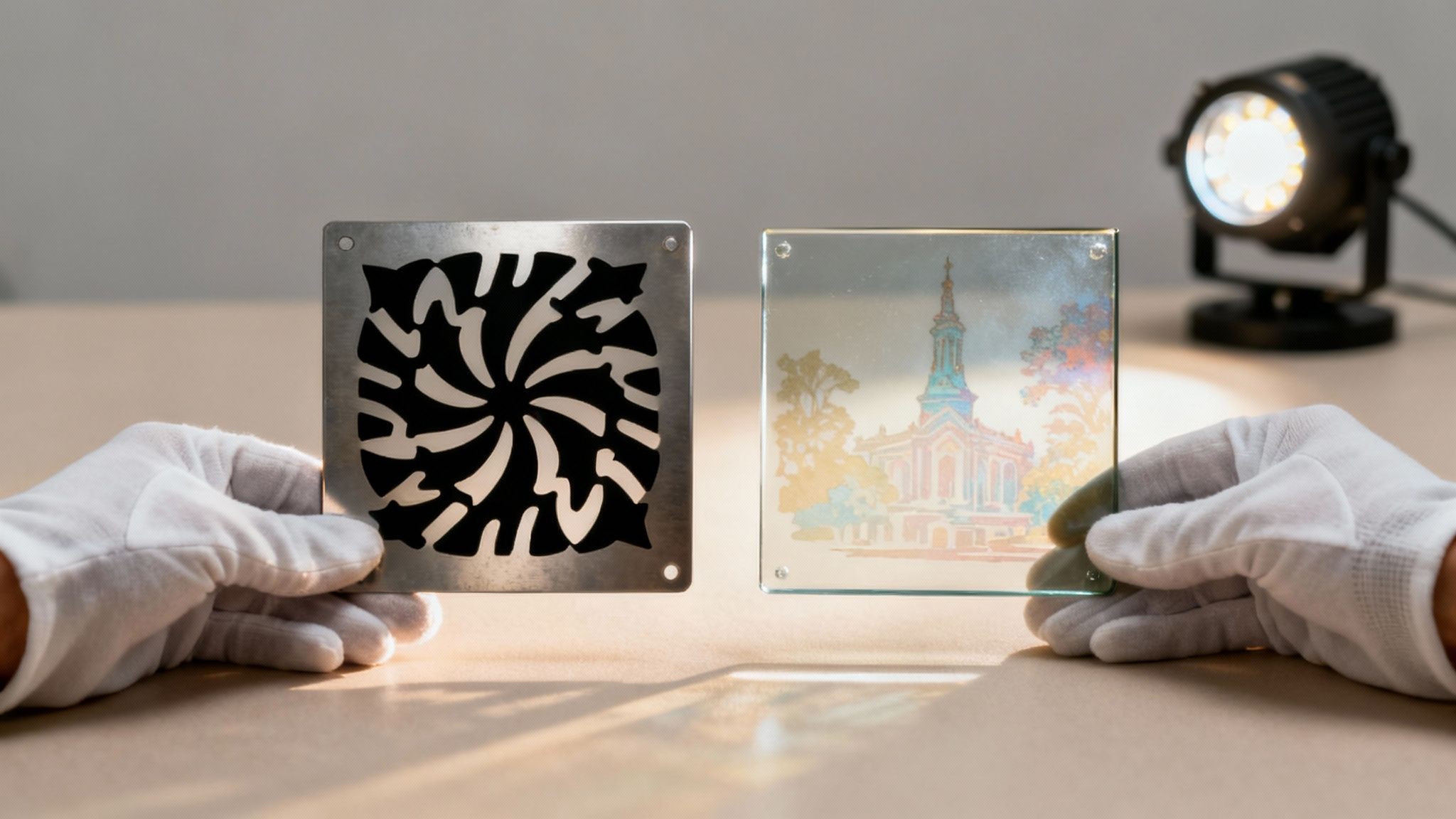
Okay, now that you've got the basics down, let's get into the fun part—picking the right type of gobo. Think of it like choosing between a stencil you cut from paper versus a high-resolution photograph. Each has its place, and the one you choose completely changes the final look.
Your decision really boils down to how complex your design is. Are you going for a simple, bold monogram, or do you need a super-detailed, full-color company logo? The answer will point you straight to the perfect gobo for the job.
Metal Gobos: The Durable Workhorse
For a lot of events, metal gobos are the go-to choice. They’re basically thin discs of steel or aluminum with your design precisely laser-cut out of them. This makes them incredibly durable and way more budget-friendly. They can take the heat and be used over and over.
Because the design is literally cut out, metal gobos are perfect for simpler, high-contrast images. We're talking bold text, cool abstract patterns, or straightforward logos. The only catch? Any design with a "hole" in it—like the letters 'O', 'A', or 'B'—needs tiny connector lines called "bridges" to hold the middle piece in place. It's a small detail, but definitely something to keep in mind when designing.
Glass Gobos: For Ultimate Detail
When your vision calls for crisp details and vibrant color, you have to go with glass gobos. Instead of being cut, your design is etched onto a special piece of coated glass with a high-resolution laser. This process lets you create incredibly complex and even photorealistic images, all without needing those pesky bridges.
Glass gobos are where the real magic happens. They can project everything from full-color corporate logos to delicate, grayscale photos. The level of detail and sophistication is just on another level compared to metal.
They are a bit more fragile and will cost you more, but the visual impact is huge. If brand accuracy or artistic flair is a top priority, glass is really the only option. To see just how elegant these can look at a wedding, check out some ideas for a monogram dance floor light.
Adding Motion with Rotating and Digital Gobos
So, you’ve picked your material, but do you want it to sit still or move? A static gobo is exactly what it sounds like—it projects a fixed, stationary image. This is perfect for a monogram above the head table or a logo that needs to stay put on a feature wall.
But if you want to add a little life to the room, you can use a rotating gobo. A small motor inside the lighting fixture slowly spins the disc, which can create some seriously cool effects. It’s perfect for things like:
- Creating a "starry night" by rotating a pattern of tiny dots across the ceiling.
- Projecting a swirling water or fire effect to build a dramatic atmosphere.
- Adding gentle movement to abstract patterns so the lighting doesn’t feel flat.
And then there's the latest and greatest: the digital gobo. These aren't physical discs at all. Instead, they’re digital files projected from special LED fixtures. This opens up a whole new world of possibilities, letting you project animated logos, video loops, or even switch between different designs on the fly. It's the ultimate in flexibility for those high-impact moments.
So, How Do You Actually Use Gobos to Transform an Event?
This is where the real fun begins. Now that we’ve covered the technical side, let's talk about how to use this knowledge to create some serious "wow" moments. A gobo isn't just a piece of equipment; it's a tool for telling a story and making a space feel completely unique.
The right projection can be the secret sauce that takes a perfectly nice venue and turns it into something personal, branded, and unforgettable. Whether it's a bold statement piece or a subtle texture that guests feel more than they see, a gobo projection sets the entire mood.
Personalize Your Wedding with a Monogram
Easily the most popular request we get for weddings is the classic monogram projection. Just picture it: the couple’s initials, maybe with their wedding date, glowing right in the middle of the dance floor. It’s an instant focal point that personalizes the whole room.
This one simple touch adds so much elegance and looks absolutely incredible in photos. While the dance floor is the go-to spot, don't be afraid to think outside the box! We've projected monograms onto a prominent wall behind the head table or even above the cake. Our deep dive into wedding gobo lighting has tons of other creative ideas.
Make a Statement at Corporate Events
When it comes to corporate events, it's all about the brand. A custom logo gobo is one of the classiest, most effective ways to leave a lasting impression. Seeing a company's logo projected in crisp, clean light as guests walk in, or behind a keynote speaker, just screams professionalism.
It shows a real commitment to detail and embeds the brand into the experience itself. A gobo feels much more dynamic and modern than a flimsy vinyl banner, making it perfect for product launches, award ceremonies, and high-stakes conferences.
A great logo projection doesn’t just show off the brand—it weaves it into the fabric of the event, creating an immersive experience that everyone in the room will remember.
Paint the Walls with Patterns and Textures
Gobos can do so much more than just logos and letters. Using pattern gobos is where you can truly get artistic and completely change the vibe of a space.
Think of it as painting with light. Some of our favorite effects include:
- A Starry Night: Projecting a sea of tiny white stars across a dark ceiling. It’s a breathtaking way to create an open-air, magical feel inside a ballroom.
- Bringing the Outdoors In: Casting soft, leafy patterns or delicate floral designs onto walls for a garden party theme or a romantic wedding.
- Dynamic Elements: Using a rotating gobo with a water effect to simulate gentle ripples across a wall or a flickering flame effect to add cozy energy.
- Modern and Edgy: Projecting clean geometric lines or abstract shapes to give a space a cool, contemporary vibe for a gallery opening or a modern party.
This kind of creative lighting is a huge reason the industry is booming. The worldwide market for stage and event lighting hit an estimated $3.2 billion in 2023, largely driven by the demand for custom techniques like this. You can see how we got here by reading up on the history of lighting fixtures. Using textures and patterns is how you set a mood that perfectly ties your whole theme together.
Navigating the Technical Side of Gobo Projections
Getting that perfect, crisp projection involves more than just a cool design. The technical details are what really separate a polished, professional look from a blurry, washed-out mess. But don't worry—you don't need to be a lighting technician to get this right.
Understanding just a couple of key concepts will empower you to communicate your vision clearly and make sure the final result is flawless.
Think of it like focusing a camera. Two of the most important factors are throw distance and lumen output. These terms might sound a little technical, but the ideas behind them are simple and absolutely crucial for getting the stunning effect you want.
Throw Distance and Why It Matters
Throw distance is just the industry-speak for how far the projector is from the surface it’s shining on. Why is this so important? Well, the farther the light has to travel, the larger and dimmer the image becomes. An image projected from 20 feet away will look much smaller and brighter than that same image projected from 80 feet across a ballroom.
For a sharp, clear projection, your lighting expert needs to know this distance to pick the right lens. A short throw might need a wide-angle lens, while a long throw requires a lens that can keep the image tight and focused. Getting this wrong is the number one cause of blurry, sad-looking logos.
This decision tree shows how gobo ideas can branch out based on the event type.

Whether it's for a wedding, a corporate bash, or a party, the goal is always to nail a specific atmosphere, and the right gobo is a huge part of that.
Making Your Image Pop with Lumens
Next up is lumen output, which is just a fancy way of saying "brightness." The real trick is making sure your projector is bright enough to compete with all the other ambient light in the room—everything from chandeliers and windows to stage lights.
A projection that looks amazing during a sound check in an empty, dim room can completely disappear once the house lights come up and guests start pouring in. You need enough lumens to cut through all that visual "noise" and make your design stand out.
A dark ballroom might only need a projector with 2,500 lumens, but a brighter space or an outdoor projection at dusk could require 5,000 lumens or more. Always talk about the venue's lighting with your vendor so your monogram or logo can be the star of the show.
Many modern event spaces also use dynamic lighting. A gobo can look incredible when paired with other effects, so it’s worth exploring how a custom dance floor with LED lighting can complement your projection for a totally immersive experience.
Which Gobo Projector Fixture Do You Need?
The final piece of the technical puzzle is the light fixture itself. Not all projectors are created equal, and the right one for you really depends on your budget and the kind of effect you're going for.
Here’s a quick breakdown of the usual suspects to help you figure out what you might need.
| Fixture Type | Best Use Case | Key Advantages | Potential Downsides |
|---|---|---|---|
| LEKO / Ellipsoidal | Static logos and monograms | Cost-effective, super reliable, and creates a sharp, focused image. | It's a one-trick pony; limited to a fixed position. |
| LED Projector | Digital/animated gobos | Extremely flexible. You can change images instantly or even project simple animations. | The rental cost is higher, and it can be less bright than a traditional LEKO. |
| Moving Head Light | Dynamic effects and movement | This is the big gun. It can move, rotate, and change colors for a full-on light show. | The most expensive option, and you'll need a lighting tech to program it. |
Getting a handle on these basics—throw distance, lumens, and fixture types—puts you in the driver's seat. It allows you to have a productive conversation with your lighting team, ensuring the tech side of things perfectly matches your creative vision. The end result? A gobo projection that truly elevates your event.
How to Design and Order Your Custom Gobo
Ready to see your own design in lights? Getting a custom gobo made is actually pretty straightforward once you know the ropes. You’re essentially commissioning a small, powerful piece of art that’s going to completely transform your event space.
The first step is thinking like a gobo. Your design needs to be clean, bold, and high-contrast, especially if you're going with a classic metal gobo. Simple designs without a ton of tiny, fussy details almost always project the best and look the sharpest from across the room.
Preparing Your Artwork File
When you're ready to submit your design, the vendor will need a specific file type. This is probably the most important technical bit you'll need to get right, but don't worry, it's not as scary as it sounds.
Here's the lowdown on what they'll be looking for:
- Vector Files Are Best: A vector file is the undisputed champion. Think formats like .AI, .EPS, or sometimes a .PDF. Because vectors use math instead of pixels, they can be scaled up or down to any size without getting blurry. Your gobo maker can resize it perfectly for their equipment.
- Raster Files Can Work (with a catch): If you only have a pixel-based image like a .JPG, .PNG, or .TIFF, it needs to be huge and high-resolution. Most suppliers will ask for at least 300 DPI (dots per inch). Sending a low-res image is a guaranteed recipe for a fuzzy, pixelated projection.
- Keep It Black and White: For a standard metal or single-color glass gobo, your design file should be in pure black and white. The black parts of your image are what the manufacturer will cut or etch away to let the light shine through.
Pro Tip: For metal gobos, remember that any "islands" in your design (like the center of the letter 'O' or 'P') need tiny connecting lines called "bridges" to hold them in place. A good vendor will usually add these for you, but it's something to keep in mind when creating your artwork.
Placing Your Order
Once your artwork is good to go, the rest is easy. You can work with a dedicated gobo vendor or, more commonly, just have your event lighting company handle the whole process for you. If you're looking for inspiration, you can start by exploring our guide to creating a beautiful wedding monogram projection.
You'll send your artwork file to the vendor along with the specific gobo size required for their projector. If you have no idea what size that is, don't sweat it—your lighting tech will know exactly what to tell them.
Finally, think about timing. Custom gobos don't appear overnight. Production usually takes a few business days, plus you need to account for shipping. To save yourself a ton of stress, it's always a good idea to place your order at least two to three weeks before your event.
Your Top Gobo Lighting Questions, Answered
Alright, so your mind is probably racing with ideas for how to use gobo lighting at your next event. That’s the fun part! But before you get too far, a few practical questions always pop up. Let's walk through the common queries we get from planners just like you, covering everything from cost to logistics.
Getting these details sorted out will help you budget properly and talk confidently with your lighting vendor to make sure your vision comes to life, whether you're inside a ballroom or under the stars.
So, How Much Does Gobo Lighting Actually Cost?
This is always question number one, and for good reason. The final price is really a mix of two things: the gobo itself and the light fixture you rent to project it.
A custom metal gobo is surprisingly budget-friendly, typically landing somewhere between $60 and $150. If you're dreaming of a more intricate, full-color design, a glass gobo is the way to go, but the price reflects that detail, running from $150 to over $400.
The bigger part of the investment is renting the projector. A standard, stationary light fixture will usually cost you between $75 and $250. When you get a complete package from a lighting company—which includes the custom gobo, the projector, plus all the setup and teardown—the total cost generally falls between $300 and $800. Of course, that price can climb if you have a more complex design, a multi-day event, or need one of those cool moving head fixtures.
Can I Use a Gobo Outside?
You absolutely can, but it’s a different ballgame. First off, projections are a nighttime-only feature. You need it to be dark, as even strong twilight can make the image disappear. Ambient light is your enemy here—streetlights, building floodlights, you name it. To compete, you'll need a seriously powerful projector with a high lumen output to make the image stand out.
You also need a good canvas. Think a flat building wall, the side of a large tent, or even a temporary screen. Most importantly, the gear has to be rated for outdoor use. You can't just stick an indoor fixture outside and hope it doesn't rain.
The biggest mistake you can make with outdoor gobos is underestimating the brightness needed. A professional vendor will ensure the projector is powerful enough to deliver a crisp, vibrant image that won't get lost in the night.
What's the Difference Between a Gobo and a Monogram Light?
This is a great question and one that trips up a lot of people. It's actually pretty simple when you break it down. Think of it this way: the "gobo" is the tool, and the "monogram light" is the result.
- A gobo is the little physical disc, essentially a stencil, that goes inside the light fixture.
- A monogram light is just a popular use for a gobo, specifically when it projects a couple's initials at their wedding.
So, while every monogram light needs a gobo to work, not every gobo is made for a monogram. Gobos can project anything you can imagine—corporate logos, swirling patterns, a starry night sky, you name it.
Ready to bring your vision to life with stunning custom lighting? The experts at 1021 Events specialize in creating unforgettable visual experiences with gobo projections, uplighting, and more. Explore our event lighting services and let's start planning.
